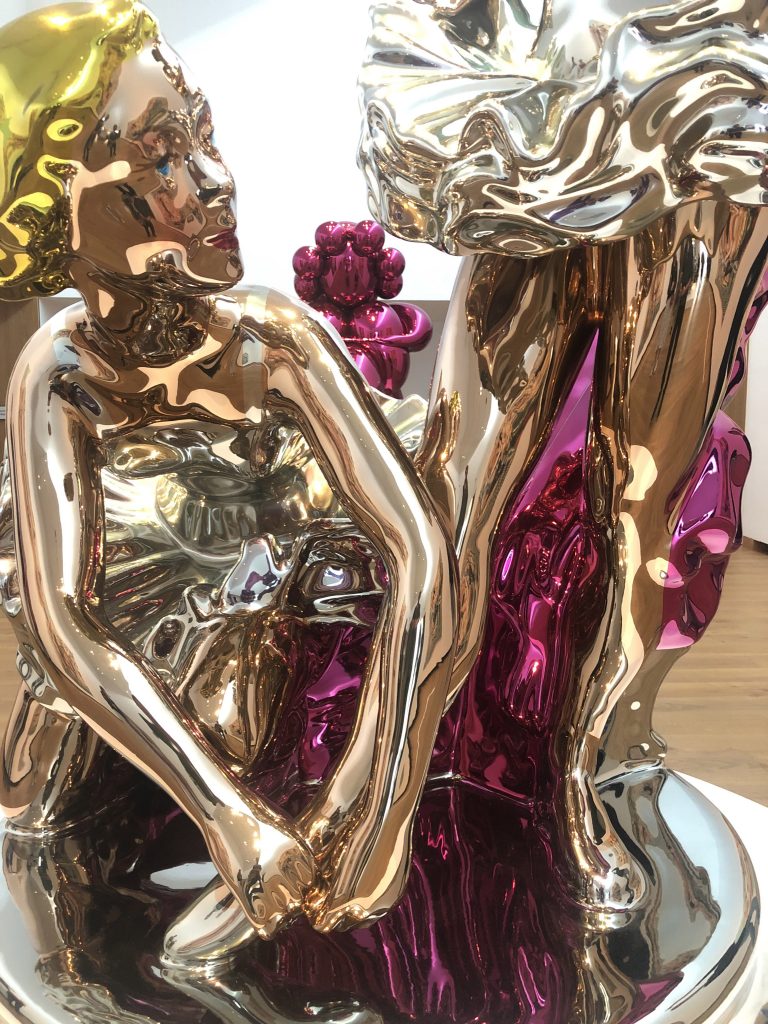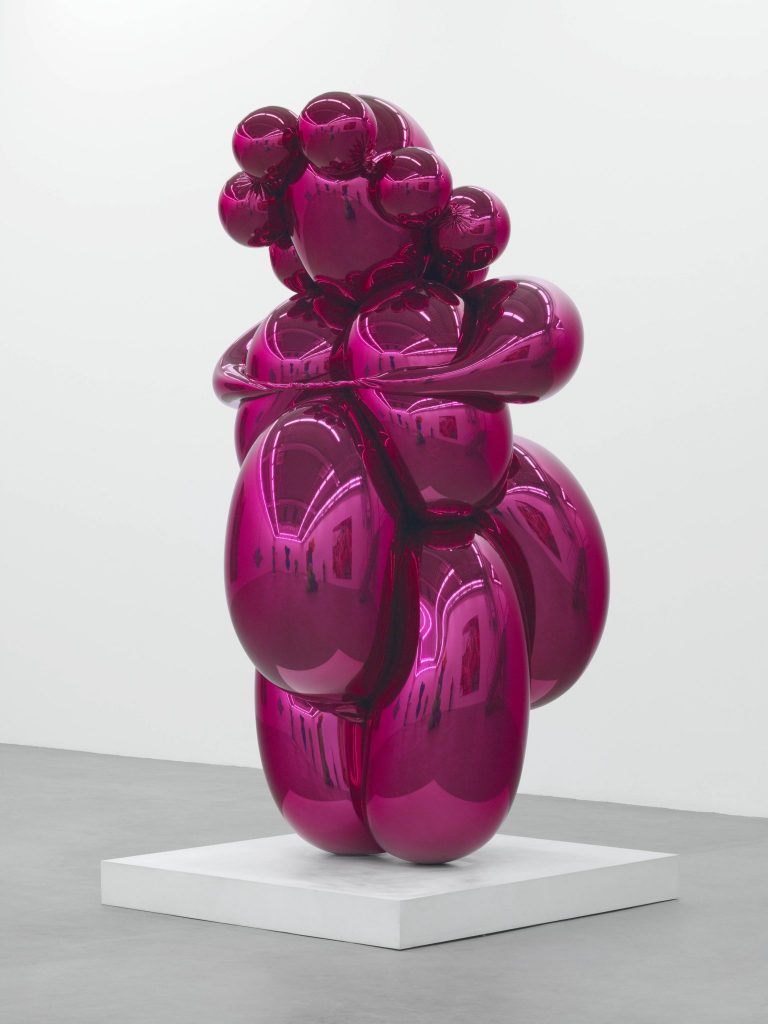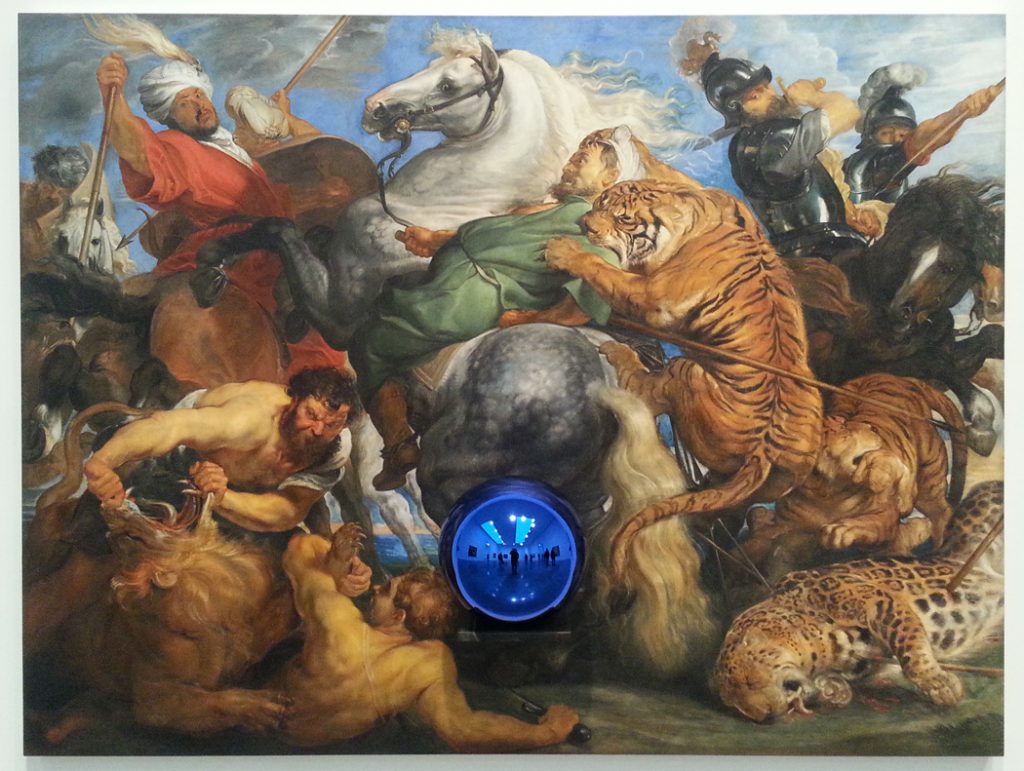Matthew Maxwell on Jeff Koons at the Ashmolean: ‘Loving the Low Brow’

Alexander Sturgis, esteemed director of the Ashmolean Museum in Oxford, was once better known as The Mighty Xa – dishevelled party magician. He had an excellent trick of pulling a string of razor blades out of his cheek. A lot of fake blood was involved, as I remember. He even published on the subject of illusion in art1Sturgis, A., ‘Magic in Art’, 1996.
Now a pillar of the establishment, and Chatelaine of the Ashmolean’s collection of knick-knackery and treasures, he has brought Jeff Koons to his museum (the oldest publicly accessible museum of its kind in the world, incidentally). It feels kind of inevitable: the Ashmolean, if you’ve never been there, is just that little bit…kitsch. So it works for Koons, who’s never been apologetic about his fascination with what he would call ‘Banality’.
As he says: ‘I don’t like to use the word ‘kitsch’ because kitsch is automatically making a judgement about something. I always saw ‘banality’ as a little freer than that.2‘Jeff Koons at the Ashmolean’, Exhibition Catalogue, 2018, p39‘
Koons is up in the attic of the building, approached through a maze of objets de vertu in glass cases: the Delftware, the small polite canvases in golden frames, the thimbles, the wicked bronze of Satan by Feuchére, wrapped like a vengeful kebab in his bat-like wings; the violins, Saxon brooches, Byzantine coins, rings, rugs and trinkets. Centuries of donations from private collectors whose tastes and predilections spanned the centuries and the globe. In this context Koons’s more iconic pieces make total sense. It’s a no-brainer to re-imagine the Venus of Willendorf in mirror-polished steel. It’s an improvement, actually. The regiments of bronze statuettes in the Etruscan cabinet transpose very logically into shiny polychromed ballerinas at rest- an aesthetic imagined by Degas and re-worked here in 21st century steel.

These statues follow a tradition of eroticism that weaves through the museum’s permanent collection like a vein of gold. The floors below are full of temptation and denial, nudity, languor and desire. Koons’s steel sculptures mimic plastic so closely that they beg to be touched, caressed- but forbid us to do so, intensifying the desire. We can feel instinctively how their ethereal perfectness would be sullied by our grubby little fingerprints. And because the objects themselves, in their ‘banality’ evoke so few associations, they become abstract. Unconcerned with the literal depiction of things from the visible world by being, literally, depictions of things from the visible world- but not significant things. And like the masterpieces of the past, we can see them, but we can’t touch them. It’s that competitive dialogue with the past that this show seems to be about.
Koons, never knowingly under-quotable, tells a story of how he tried out for middle school football but got ‘cut’ in the first trial – he hadn’t bothered to read the rules. It seems to have been a formatively humiliating experience for what I imagine to be the young, sensitive Jeffrey, tossed into a world of hormonally charged competition. Like Trump’s humiliation by Obama at the Correspondents’ Association dinner in 2015 (which supposedly inspired Trump to the presidency, powered by a desire for revenge), Koons explains how he never wanted the same thing to happen to him in the territory he resolved to compete in: ART.
It was ‘…important to know the rules and never have anyone know them better3Ibid., p11…’
For any artist, the competition includes, is even mainly about, the masters of the past. It’s the challenge every creative individual either eventually or continuously encounters: when everything’s been done before (often many times, and usually better) what’s left to do? How can I make my mark? How can I WIN!? With Koons you never quite lose the sense that for him, the past isn’t so much a generous parent as an annoying sibling.
It’s a tense relationship.
It’s complicated.
Koons is the kid always looking for a chance to put one over on his bigger, more worldly brother. That resentful envy was revealed most nakedly in his ‘Made in Heaven’ series with La Cicciolina, who, with her flowery garlands and shimmering see-through drapery, always seemed like something come-to-life from a Pompeiian bath house fresco. ‘Look, classical world, that’s me and your girl Erato, flattening the pansies.’

But when this rear view driving becomes too overt, it fails pretty abysmally. The mimetic copies of iconic canvases by Gericault, Titian etc. are appropriated with a blue ‘Gazing Ball’ stuck on the front. Gazing Balls are those things you buy at the garden centre and stick in the rockery. Spherical aquamarine reflecting ponds, and quite pretty in themselves, ingeniously allowing you to gaze at yourself and the painting AT THE SAME TIME! This is the rich collectors dream – me and my multi-million-dollar painting (which isn’t exactly an Old Master but looks a lot like one!) in one gluttonous eyeful! And the stupid canvas prints of ‘antique stuff’ with swirly lines on top, and called, d’uh, ‘Antiquity’, look like they belong on the walls of a hotel lobby. Simultaneously respectable and saucy. Koons probably would say that was the intention, but it doesn’t stop them being plug-ugly and puerile. But they sure look expensive, which is maybe the point.
Koons’s work is all about the depiction of things and stirring the bucket of associations that they conjure up. When it works, and especially in the Ashmolean context, there is real clarity at the intersection of concept, context and execution. There is genius. When it doesn’t, there is something else, waaaay down the other end of the scale. But that’s what makes this such an interesting show.
It fails as often as it succeeds, which is what artists are meant to do.
It entertains and opens the mind to the accumulation of treasures under the same roof. Koons talks (a lot) about empowerment – less a transformative power, more a propulsive one – that the tiny, failed footballer that nestles naked somewhere deep inside his demonic gut uses to assert himself as one of the high Knights of the Artistocracy. But here, the maiden aunt Ashmolean and the brash New York millionaire Koons show how, in dialogue, the past can be harnessed to provide a power that is undeniable.
Jeff Koons, ‘Antiquity (Ariadne Titian Bacchus Popcorn)’ (2012-14), oil on canvas, 259 x 350cm
3 thoughts on “Matthew Maxwell on Jeff Koons at the Ashmolean: ‘Loving the Low Brow’”
Comments are closed.
Well isn’t the whole paradox of “lowness” that it’s become some sort of luxury item? I dunno. But hey- you can’t completely hate koons. He’s no different from any abstract artist. He wants to make pretty merchandise for the wealthy to feel clever.
Making art to make the wealthy feel clever is a noble and ancient tradition. The second oldest profession.
When I see Koons’ current work I’m reminded of the props in Stanley Kubrick’s ‘A Clockwork Orange’, those in the Milkbar and the studio of the artist who’s bludgeoned to death with one of her sculptures, which seems like an apt and clever appropriation for Koons. That said, I really could care less about his work and am disgusted by his attempt to rape Paris with a sculpture that attempts to capitalize on the Bataclan massacre.